Genre: Shmup Developer: Sega of Japan/Denpa Pubisher: Sega Enterprises Players: 1 Released: 1990
In 1986, the movie Top Gun was a big hit. Over a year later, Sega capitalized on that film’s continued popularity by releasing two games that put players behind the controls of an F-14 Tomcat… After Burner and After Burner II. Their fast-paced action, state-of-the-art visuals, and rock-inspired soundtrack drew players in, and they quickly became a major feather in Sega’s cap. Ports of the second arcade game came to various systems in ’88 and ’89, but it wasn’t until 1990 that it arrived on Sega’s Genesis system. Did it take the highway to the danger zone, or crash and burn on takeoff? Read on.
General Zorbia and his forces from Halvary have invaded your nation. They’re preparing to deliver the final blow by using outside help from along the NESW communications network. However, in order to contact that help, the Halvary HQ must send their message through two microwave stations. If these two stations are taken out, the Halvary forces won’t be able to make that transmission, and your nation will have a fighting chance to drive them out. Stationed aboard the carrier Sega Enterprise some two hundred miles offshore, you’re to climb into your “Skycat” F-14XX fighter and take out those microwave stations.
Now, let’s be honest. There’s no way the Genesis can visually match Sega’s X-Board, which powered the arcade classic. But this little 4Mb cart does its best to mimic its big brother. The ground isn’t as populated with rocks, bushes, and buildings, and it has been simplified quite a bit. However, the simpler ground graphics do scale well, as do the missile smoke trails. The enemy aircraft have been given considerable attention scaling-wise, and as a result, they zoom in from the background very smoothly. The graphics themselves have good detail on the ground objects, aircraft, and explosions, and while the latter two are also simplified a little, but they still resemble the arcade well. Finally, the tilting and rotation of the ground and objects are handled nicely, and overall, the visuals of the game do the arcade original some justice.
When it comes to sound, the Genesis version stacks up better than one might expect. The music is handled quite well, with instruments that resemble the higher quality ones from the arcade. It’s a bit staticy and quieter as it plays, but it still does a good job staying true to the original tunes in many respects. The sound effects are much the same in terms of quality. While staticy, they also sound rather similar to the arcade. Missile launches, explosions, and several of the voice samples are here, making the Genesis version a solid aural reproduction of the arcade game.
The gameplay is pretty straightforward, much like in the arcade. You have your Vulcan cannons for taking out closer enemies, and lock-on missiles to take out everything else. You can speed up, slow down, kick in afterburners, and do barrel rolls, all to try and get away from enemy planes and missiles in front and behind you. You have a limited number of missiles to start with, but every few rounds, you’ll dock with a large plane that restocks them with fifty more. Also, the controls are spot on, which is good considering all the dodging you’ll be doing in the later levels. This all adds up to a very similar experience to the original game.
As one might expect, this version isn’t perfect, as it does have a couple problems. First, the land is very simplified, and it feels strange to see an inanimate ground sprite get revealed and covered up as you dive and climb in the game. It does tilt and spin as you bank and roll, and the scaling graphics moving over top of it help hide its static nature somewhat, but it still looks odd.
The second main thing is that there are some graphical glitches and flicker that appear during the game. You can see the glitches on the rock columns and trucks/tents during the ground missions, while the flicker comes up when there are a lot of objects on the screen. The flicker is easy enough to see why it’s there, but you’d think someone would have caught and fixed the visual glitches before the carts were mass produced.
Besides those two main issues, there are a couple minor things too. The cool landing sequences are gone, and the graphics only scale up to a point. The last bit hurts the 3D effect somewhat, as things don’t get right up in your face like they did in the arcade. It’s a little disappointing, but at least we get much better scaling than previous 3D games on the Genesis.
When Sega decided to bring its arcade hit home, you know it wanted it to be good. And despite being a small 4Mb cart, After Burner II manages to be exactly that. It’s a toned down port that lost some punch visually and aurally, but the core gameplay is intact, it has a great sense of speed when things start heating up, and it pulled off some above-average 3D on a system with no scaling capabilities whatsoever. It may not a perfect port like the Saturn version, or a really close one like the 32X version, but it’s a respectable take on an arcade classic that’ll likely please fans of Sega’s 16-bit system.
SCORE: 7 out of 10

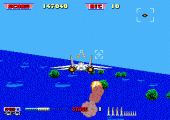
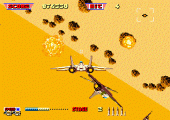
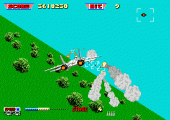
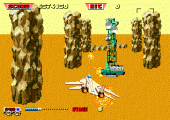
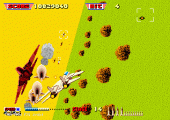
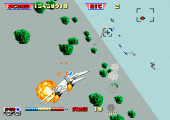
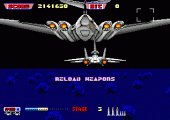
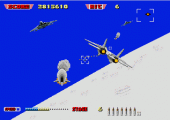
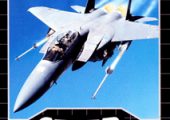
Am I the only one to think that this version of After Burner II isn’t well developed? It has impressive scaling and so what? CONCLUSION: 5.5/10